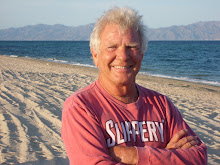Here is my trusty Sherpa. The sea is in the background. Below is the Honda 110 Scooter that I had the first day while new brakes were being put on the Sherpa. The Sherpa is much nicer.

I had a lot more to say, so now I am back in Mirtos at the restaurant of Yiannis, good red wine, good Greek music, speaks English, cooks well, and lets me use his PC. There are more restaurants and tavernas than seem necessary, but I hear it gets mobbed here in July and August. The roads here are windy and twisty for the most part, perfect for a super motard, but I haven't seen any yet. There is a surprising number of larger bikes, TransAlps, V Stroms, and R1200's. Especially considering the island is 60 Km by 300 Km, it seems an overkill. Cars are typical small European and a lot of Chinese motorcycles in the cities. Speed limits are never greater than 90 kph, or 55 mph. The highways are not well marked with numbers, but the cities are. So I just navigate from one city to the next and only got lost twice today. Never did get to where I was headed, but I think I wound up where I was supposed to be. There was a tremendous wind coming down a canyon as I was coming home. It was the stiffest I have ever seen and I had to walk the bike across the bridge. I just had to hold on until it let off a bit, then gain 10 feet or so before it cranked up again. Gas is 1.54 euros per liter which works out to $8 per gallon. So yes, the roads are rather empty. Otto








